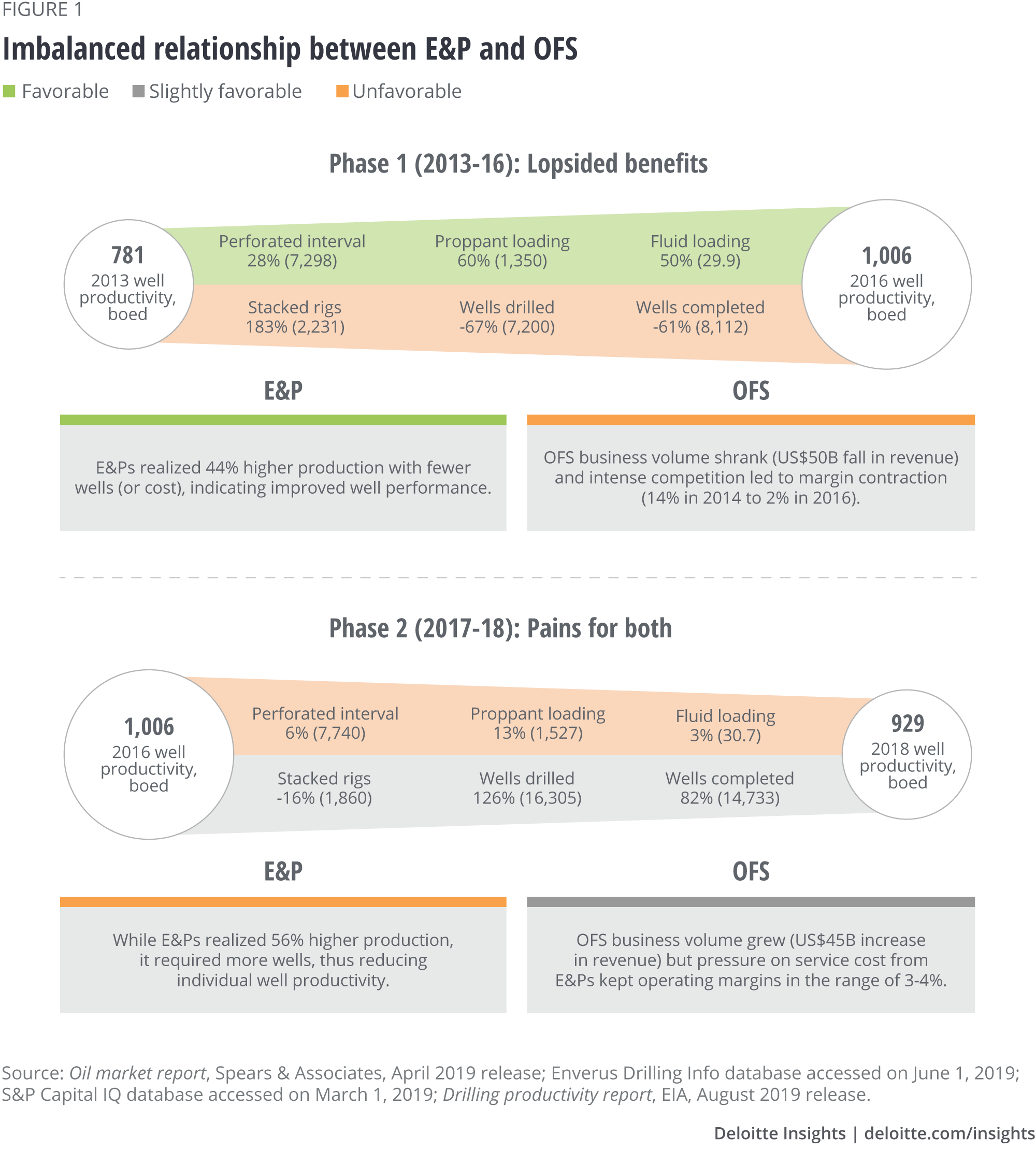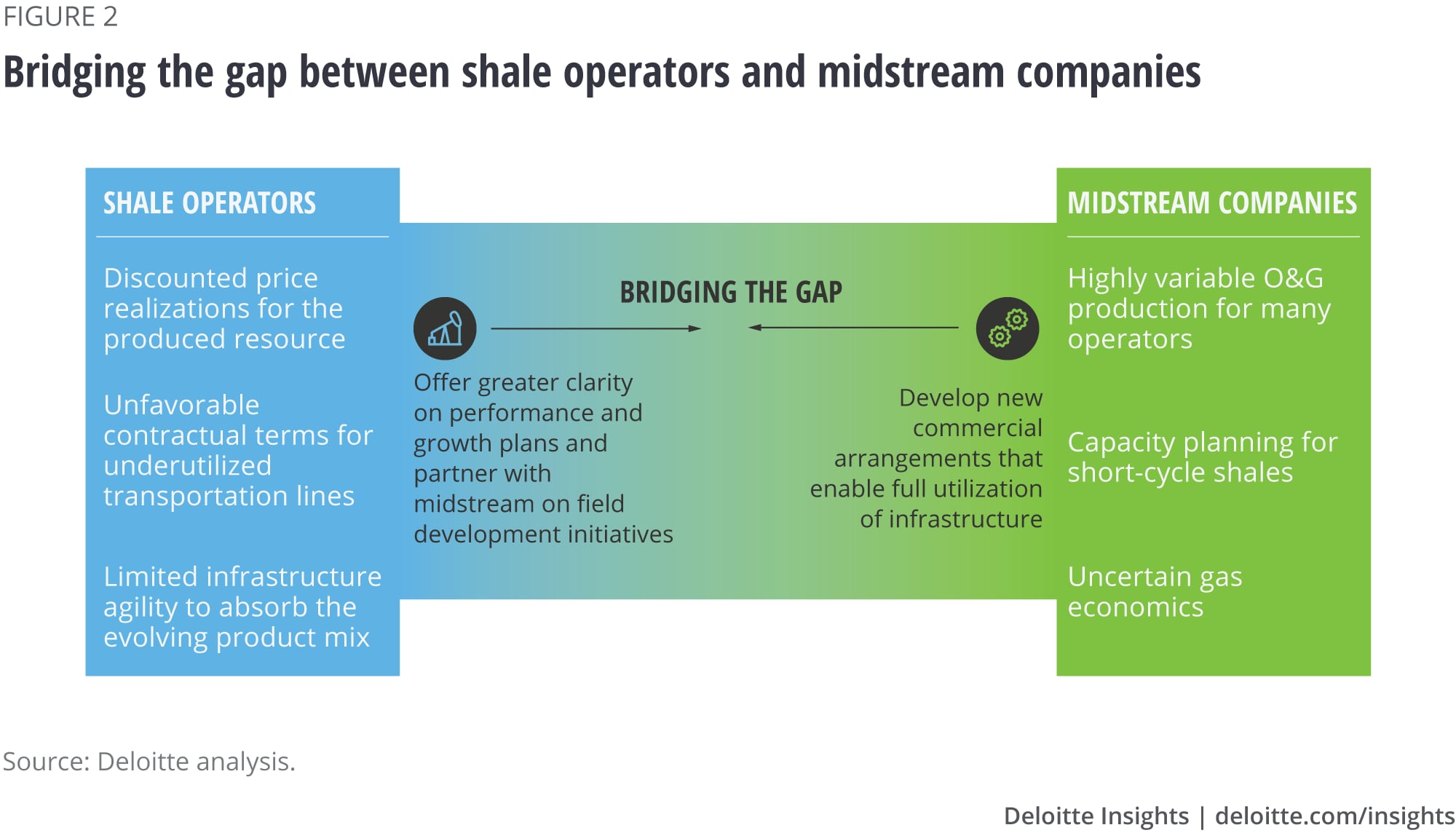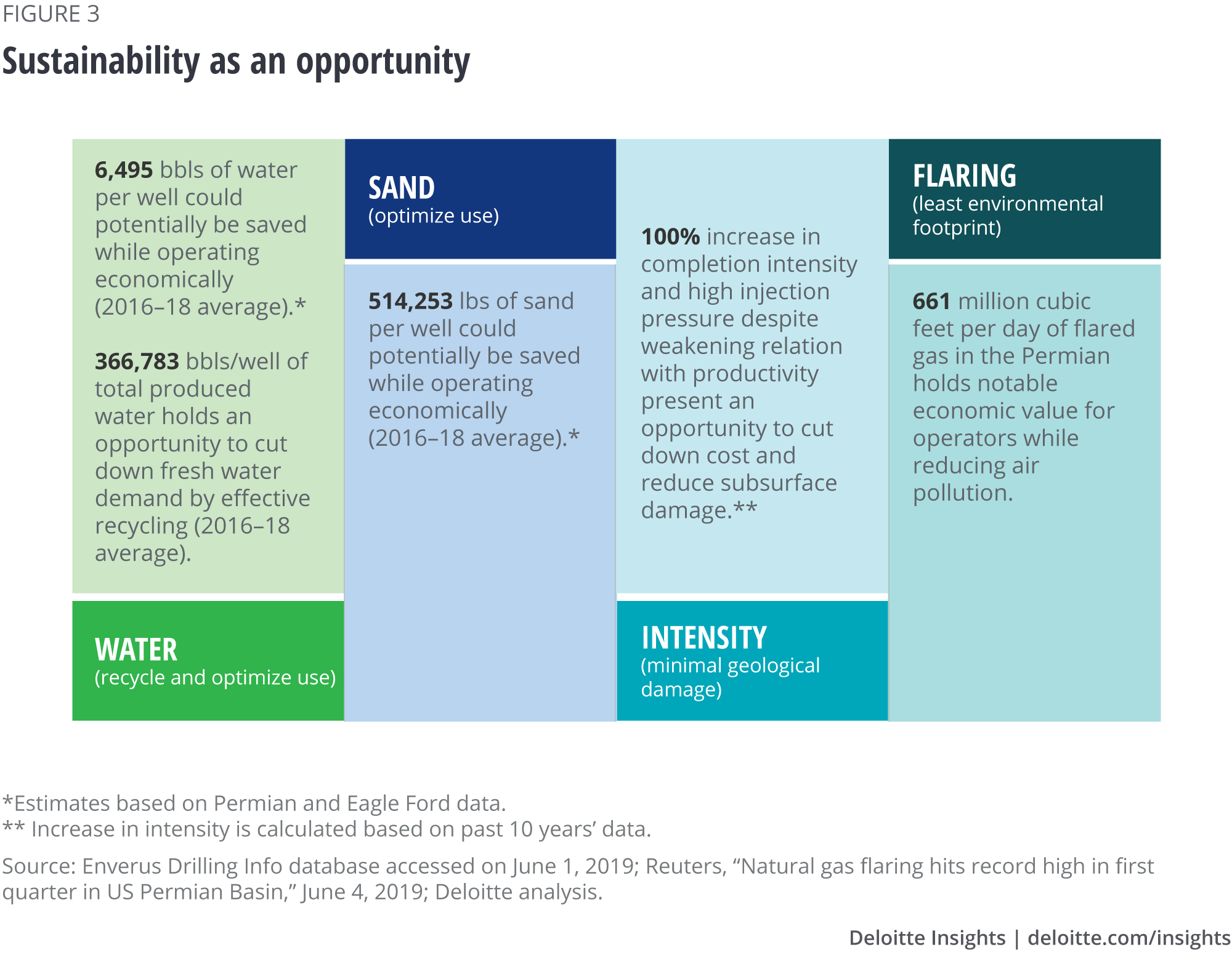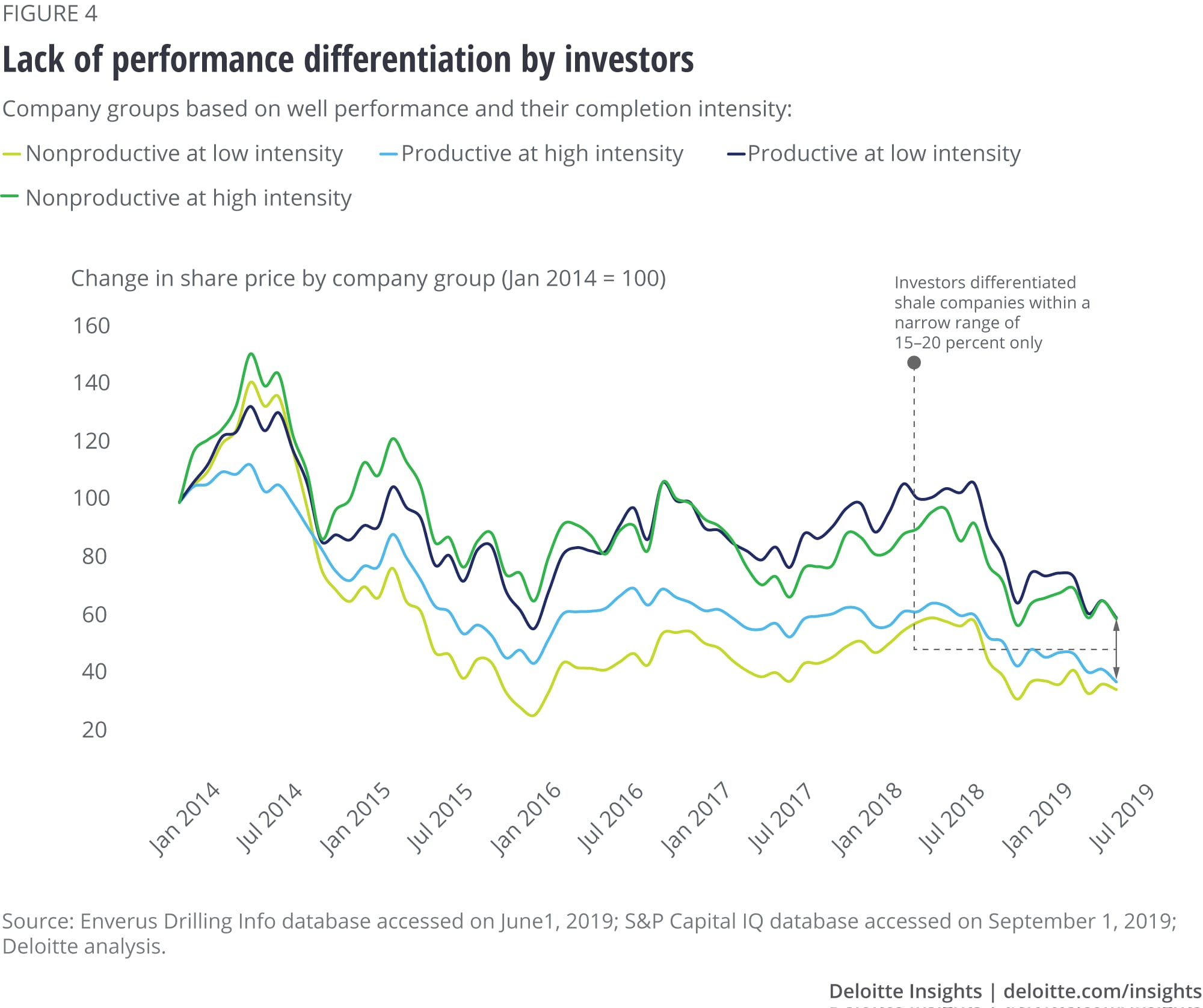
Shale’s next act: Collaborate to magnify and extend the opportunity Moving the US shale revolution forward
12 minute read
23 October 2019
 Duane Dickson United States
Duane Dickson United States John England United States
John England United States Andrew Slaughter United States
Andrew Slaughter United States Anshu Mittal India
Anshu Mittal India
Shale’s continued resilience during the lower oil price environment indicates a promising outlook for the next decade. But as the resource matures, all stakeholders will have to work together to help realize its full potential.
Executive summary
The phenomenal growth in the last 15 years, the unexpected resilience in the past five years of the O&G downturn, and a promising outlook for the next decade sum up the entire story of America’s biggest energy revolution, the shale boom. The revolution has not only accelerated the nation’s march to energy independence but also fostered a new era of technological innovation and connected ecosystems in the O&G industry.
Learn more
Explore the collection
Read more in Oil, Gas & Chemicals
Download the Deloitte Insights and Dow Jones app
Subscribe to receive more content from Deloitte Insights
But as with any new product or resource, such as shales, the early phase of growth is also the initial phase of evolution and experimentation. And when this phase of learning matures, the sustainability and economics of this growth could start making much more sense and even open a much bigger, “untapped” potential. Our meta-analysis on two of the most prolific shale basins, the Permian and Eagle Ford, highlight opportunities of enhancing O&G recovery (EUR) per unit well cost by 19–23 percent (refer The Permian basin playbook: Optimizing design experimentation and The Eagle Ford basin playbook: Focusing on capital efficiency).1
Higher oil prices can make shale operators blind to this opportunity or hide these inefficiencies, while lower oil prices can expose the cracks and make it more essential and challenging for shale operators to realize the opportunity. Some mounting fears of a global economic slowdown, unfortunately, suggest the probability of the latter. “The world’s demand for oil is (already) growing at the slowest rate since the financial crisis over fears of a global economic slowdown,” according to the International Energy Agency (IEA).2
Our four-part article series, Moving the US shale revolution forward, aims to study the learning curves, unearth success factors, and identify operational well-enhancement opportunities for US shale operators. The analysis is based on Deloitte’s statistical interpretation of reported well-level geological, engineering, and productivity data.
The analysis focuses on aggregate performance indicators across the plays. It is intended to complement, not replace, companies’ sophisticated geological and field planning models of their own operations. The opportunities highlighted in these articles are at a well level, as against at the overall field/portfolio level. Given the heterogeneity of shale geology, operators could use this analysis to identify specific factors to explore in their own proprietary drilling, completion, and operations data.

In such a scenario, just optimization of well designs, and disregarding the current state and future responses of other stakeholders in the O&G ecosystem, could hinder operators from taking full advantage of this opportunity. In particular, US shale operators should take along and work with two key stakeholders to seize this opportunity and, most importantly, safeguard the long-term promise of shales:
- Oilfield service providers: For minimizing service cost inflation and maximizing well productivity, but without further hurting their business, innovation, and sustainability.
- Midstream companies: For having an infrastructure that provides realizations of products at market prices, matches with shale production profiles and product-mix trends, and rationalizes commercial arrangements.
An interactive, healthy ecosystem would get the license to operate only if companies overperform on a broad set of environmental measures and win investors’ trust in the shale business by:
- Self-regulating themselves and going beyond voluntary reporting to foster higher levels of environmental responsibility and leadership.
- Bringing more transparency, standardization, and thoroughness in their reporting of operational performance and results, both at a well and portfolio-level for investors.
Oilfield service providers: Partnering for efficiencies
A problem at the operator’s end—falling well productivity—should typically mean more business for oilfield service (OFS) firms. But knowing that the oil price collapse pushed operators to overpower service firms even during high-productive days, operators may not make it easy for service providers if the going gets tough for them. In fact, today’s lopsided relationship between the two suggests that operators may likely continue to engage with service firms in one of two ways: Operators push service firms to lower their rates/services further in a bid to save cost, or they demand higher well efficiencies from OFS firms but without sharing benefits.
But both these approaches will likely fall short of addressing the industry’s real productivity challenges or enabling the US$24 billion opportunity. In fact, these approaches would again risk both operators and service firms getting caught in price/cost cycles, thus creating a further imbalance in the shale ecosystem. The first approach, of squeezing more out of the service industry, could question the sustainability of the US OFS industry, which is already seeing its weakest margin profile ever (operating margins of barely 3—4 percent in 2017 and 2018).3
Although the second approach could be slightly better than the first for both parties as it focuses on value addition, service providers might remain skeptical and thus less willing—or less innovative—due to their past experiences. During the 2013–2016 period, for example, the efforts of OFS firms in raising well productivity without any incentives came at the expense of their overall business growth (e.g., lower requirement of rigs), eventually making them the victims of their own success (see figure 1).

A healthy and sustainable way to monetize this opportunity for operators is to co-own the productivity problem and coshare the benefits with service firms, apart from an operator using analytics to drive better insights from well designs. Both parties could benefit from resolving underperforming contracts; eliminating waste through joint planning and execution; upgrading terms and conditions by avoiding excessive risks; and aligning their value proposition through output-driven supply models. An integrated asset plan can fully unlock the acreage potential for an operator and, most importantly, transition the shale industry from a linear to an agile production or manufacturing process that self-learns and doesn’t end at the well-delivery phase.
Occidental Petroleum’s Aventine project, a maintenance and logistics hub in the Permian, is an example of how parties across the value chain are working together to improve their cost structure and capital intensity.4 Similarly, when the service fees/day rates are tied to performance metrics, it could not only incentivize the service provider to bring new efficiencies, but can also normalize the uncertainty in productivity and cost cycles for both parties. Put simply, an adoption of performance-based contracts, by moving away from a fixed revenue/fees per foot drilled and toward a progressive fee structure linked with incremental productivity and cost per lateral length completed, would help both operators and vendors.
Midstream companies: Collaborating to cocreate value
Midstream infrastructure, a lifeline for shale growth, has constantly struggled to align with variable shale production. A pause in shale growth during 2015–16 left many midstream assets underutilized, while a rapid surge in volumes post-2017 didn’t allow enough time for companies to install new pipelines and processing capacity.5 These capacity bottlenecks led to steep pricing discounts which reduced the netbacks for shale operators—in mid-2018, the oil price in West Texas was trading US$23/barrel (bbl) below the coastal price in Houston.6 Moreover, the rise in gas volumes in oil-heavy basins (Permian basin oil cuts have fallen by 10 percent in the last five years) with no additional pipelines, has worsened the situation for operators.7 Natural gas spot prices in 2019 at the Waha hub fell to minus US$3.38/million British thermal unit (MMBtu)—i.e., operators were paying those with spare capacity to take the unwanted gas.8
This intrinsic lag restricts shale players from realizing the expected value of the produced resource and it could reduce the benefits of the discussed operational enhancements (the US$24 billion opportunity).9 While appreciating that some lag could persist due to different project cycles, it can be crucial to minimize this gap for the betterment of the whole ecosystem. Although midstream firms acted quickly by enhancing the capacity of existing projects (adding horsepower, pump stations, new connections, etc.), the scale of expected supply growth would likely require more sustainable solutions.
Tackling this would require midstream firms to move away from reacting to supply growth and start partnering with operators to not only gain clarity on the latter’s growth plans, but to also offer them insights on identifying best operating zones (from an infrastructure perspective) (see figure 2). For instance, four pipeline operators developed a cognitive tool, which integrates operational and economic aspects of basin production, infrastructure, contracts, etc., and then allows users to run scenarios in a virtual, collaborative environment. This allowed midstream firms to plan changes to the gathering lines in real time based on inputs from E&Ps, while it helped E&Ps prioritize the new production sites that could offer the best economic returns from pipeline infrastructure, taking into account an end-market perspective.10

Apart from infrastructure constraints, unfavorable transportation pricing arrangements could prevent shale operators from realizing the full value of their resource. In the event of an unplanned decline in production, the per barrel of oil equivalent (boe) transportation fee increases notably in utilization-based pricing contracts and hence E&Ps face the double whammy of fall in production and increased operating expenditure—six E&Ps used the bankruptcy route in 2018 to exit such unfavorable contracts.11 Another example is where an independent O&G company recently got a permit to flare all its Eagle Ford gas despite having an active contract with Williams, as transporting gas under the “uneconomic” contract would have resulted in a US$146 million loss to the former.12
Owning transportation lines is one way to handle this, but it might not be a viable option for many, as it might disrupt the opex-capex (operating expenditure-capital expenditure) equation for small- to mid-sized E&P operators. For instance, ExxonMobil has committed US$2 billion for the development of pipelines and terminals in Texas, as it sees value in having a complete integrated value chain in the region.13 A viable option for E&Ps and midstream firms would be an arrangement where the former is charged a stable minimum fee while the latter get full utilization of its assets. One such arrangement is acreage allocation by E&Ps to midstream, in exchange for favorable pricing and exemptions for unplanned fall in utilizations. Some midstream players are further offering a DrillCo-style14 financing clause for E&Ps in case capital crunch leads to production decline.15
In short, it is important for both businesses to work in tandem to minimize gaps in infrastructure and have a mutually beneficial commercial arrangement. Once done, it could help operators gain access to promising end markets and minimize untransported volume, while ensuring profitable growth for midstream with increased asset utilization at an “optimal” transportation fee.
Self-regulation: The key to operating sustainably
Many shale operators have stayed committed to reducing the environmental footprint tied to drilling, completion, and production. Some companies have even created a product differentiation for their commodity by marketing their efforts to operate in an environmentally responsible way. For example, in late 2018, Southwestern Energy sold certified “responsible gas”16 from its West Virginia wells to a northeast energy company, with the latter paying a premium price for that.17 Since getting such premiums is desired yet rare, sustainability efforts are viewed as a cost element driven by regulations and investor pressure. Many state regulators in the United States also highlighted their challenge in reducing onerous restrictions on operators, while assuring sustainability of operations.18
Finding an economic incentive in sustainability efforts could solve this challenge and drive self-regulation by operators (see figure 3). If sustainability is tied to the US$24 billion opportunity, the case for swift actions could become stronger. For instance, operating in the optimal design range in the Eagle Ford and Permian (for more information please refer: The Permian basin playbook: Optimizing design experimentation and The Eagle Ford basin playbook: Focusing on capital efficiency) could not only maximize recovery per unit cost but could also help the environment by saving 6,495 bbls of water and 514,253 lbs of sand per well.19 Similarly, notable economic and environmental gains could be realized by reducing the intensity of completions where it may not result in increased productivity.

In fact, conscious sustainability measures could expand the previously discussed opportunity to enhance the economic efficiency of shales. The produced water volume in the United States, for instance, surged 20–25 percent over the past 10 years to reach 366,783 bbls per well—promoting its reuse could reduce the load on water resources and cut down cost.20 In 2018, Range Resources achieved a 153 percent water recycle rate in Appalachian by recycling water from all of its wells and from those of nearby operators through a water-sharing pact. It saved US$10 million in capex for the firm, reduced freshwater consumption, and even improved traffic issues and air quality in the region by reducing the truck trips (earlier used to dispose water) by 100,000.21
Likewise, flared gas management also holds notable opportunities for operators—flared volume in the Permian could serve the gas needs of Texas’ seven largest cities. Although there is a direct incentive in minimizing flaring, the dependence on midstream infrastructure typically restricts the operators from realizing the full economic value of resources. Companies such as CNX Resources have tried to tackle this by using the produced gas to power the fracking fleet, which reduces the fuel cost and helps them operate “well below” the EPA’s Tier 4 emission standard.22 High stakes and commitment to the environment could also create new uses for produced gas— the US Department of Energy launched a US$3.3 million project with Schlumberger and Southwest Research Institute to create a foam using produced natural gas that can serve as base fracking fluid.23
So, instead of looking at sustainability efforts as costly restrictions, they can be viewed as self-regulations that not only potentially reduce the capex and opex of operations, but also add a premium for products and garner a thumbs-up from the investor community.
Investors: Winning back trust through more transparent reporting
US oil and gas production is at an all-time high of 27.8 million barrels of oil equivalent per day (boed), but many investors in the companies driving this revolution are still waiting for their payday. For example, an investor who put US$100 in the Dow Jones US Select Oil E&P Index in 2014 would be left with just US$63 by the end of August 2019.24 Rising bankruptcies, mounting debt, and negative free cash flows continue to weaken the trust of financial markets. But with the recent productivity trend turning negative, even retaining investors’ trust would be a major challenge for shale operators.
Winning investors’ (especially retail’s) confidence would likely require operators to address productivity and cost imbalance, which has widened over the past two years, and be more transparent and thorough in their reporting of operational excellence. Optimizing productivity per unit of well cost, however, could yield partial gains if the progress is shared with investors only for select wells. Put simply, as against marketing their (few) best wells, operators should give a complete picture of the entire portfolio of wells to investors. Without that, investors can find it challenging to appreciate performance, differentiate performers, and could thus end up painting every company with the same brush.
Over the past five years, for example, investors differentiated shale companies within a narrow range of 15–20 percent only.25 In fact, shale companies with low productivity and high completion intensity received the same level of response/reward from investors as against the ones that were high on productivity and low on completion intensity (see figure 4). Overcoming this nondifferentiation likely calls for having a comprehensive set of shared metrics, which could standardize comparisons across companies and provide a complete view on a company’s progress, both at a well and a portfolio level (see The portfolio predicament).

Instead of simply relying on operators, large institutional investors, energy agencies, and shale industry associations, along with data aggregators, could play a big role in bringing a level of normalization for the shale industry and its investors. When done, standardized indices that track the formation quality of wells, dissect the complexity and intensity of completion designs, normalize productivity per lateral length, and provide a portfolio-level view—similar to the indices highlighted in Deciphering the performance puzzle in shales —would allow investors to differentiate performers and remain on top of the evolving trends in the shale business.
A well-informed investor can enable the US$24 billion opportunity in many direct ways: providing greater access to capital, reducing the cost of funding, balancing expectations on payouts, among many others for shale operators. The bigger prize, however, is the conversion of operational excellence into shareholder gains. According to our 10-year analysis of 1,450 US manufacturing companies, a dollar increase in their free cash flows has resulted in a 1.6x increase in their market capitalizations.26 By this logic, the US$24 billion optimization opportunity for US shale operators could enhance shareholder wealth by US$40 billion.27
Bringing everything together
In the past decade, the “young” shale resource has not only solidified its place in the US energy mix but also transformed the entire O&G landscape. Challenging questions about its sustainability during the early years of the oil downturn, operators demonstrated their strength by achieving remarkable productivity and efficiency gains to make shales competitive with other resources. And it doesn’t stop here—our analysis clearly outlines that the shale learning curve has not matured and it holds notable upside potential once operators augment their technical understanding with experiences of their peers.
The value at stake is significant, but to realize the full potential of this opportunity all stakeholders should work in tandem by combining technical know-how with new digital and analytical capabilities. A joint effort to course-correct various operational and commercial arrangements would also ensure a fair value split among the sectors. Once done, the industry might no longer be defending their actions or questions on shales’ sustainability but charting out a roadmap to extend and replicate the shale revolution to all the basins.
© 2021. See Terms of Use for more information.
-
How the shale revolution is reshaping the US oil and gas labor landscape Article6 years ago
-
Oil’s well?: Divergence and imbalance in the oil and gas ecosystem Article5 years ago
-
One Downstream Article5 years ago
-
Energy management: Paused by pandemic, but poised to prevail Article4 years ago
-
Refining & marketing: Eyeing new horizons Article5 years ago











